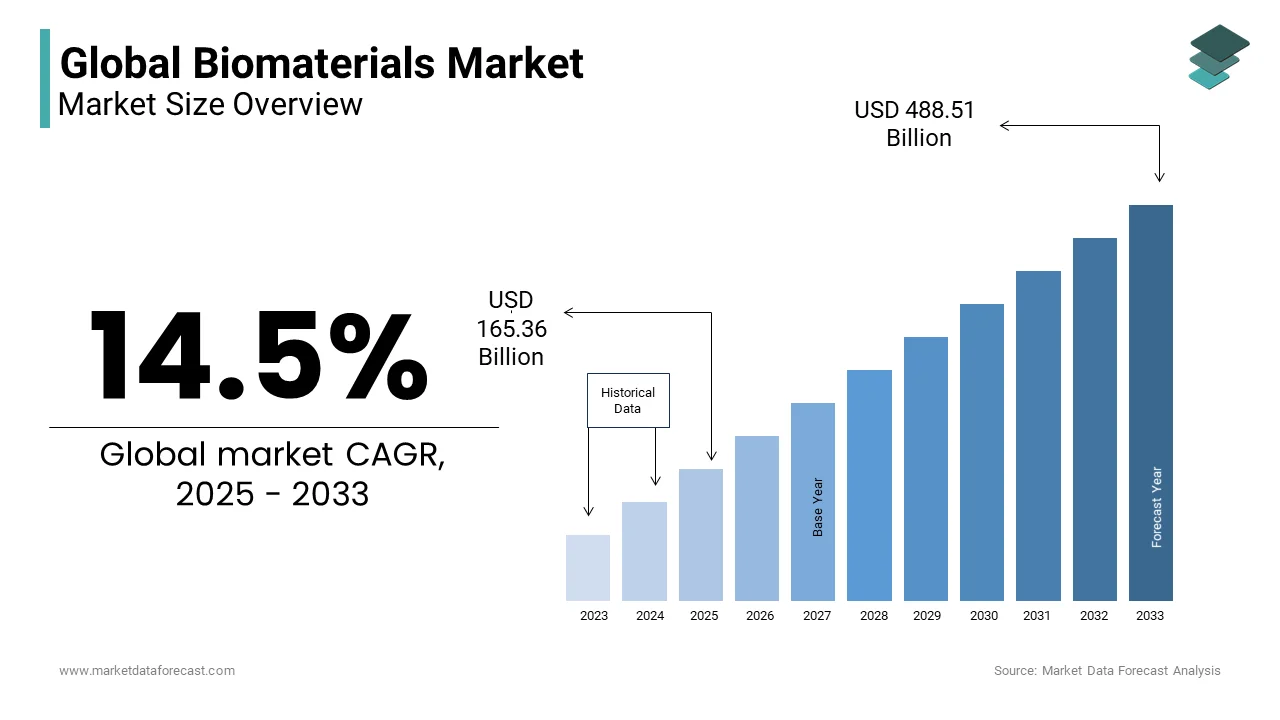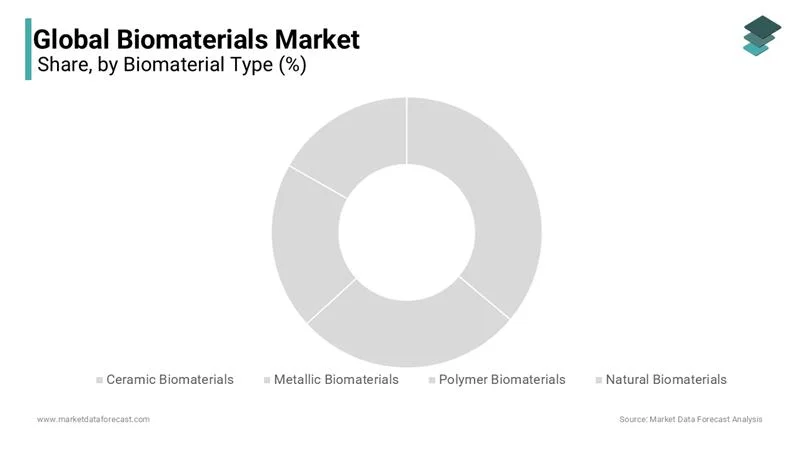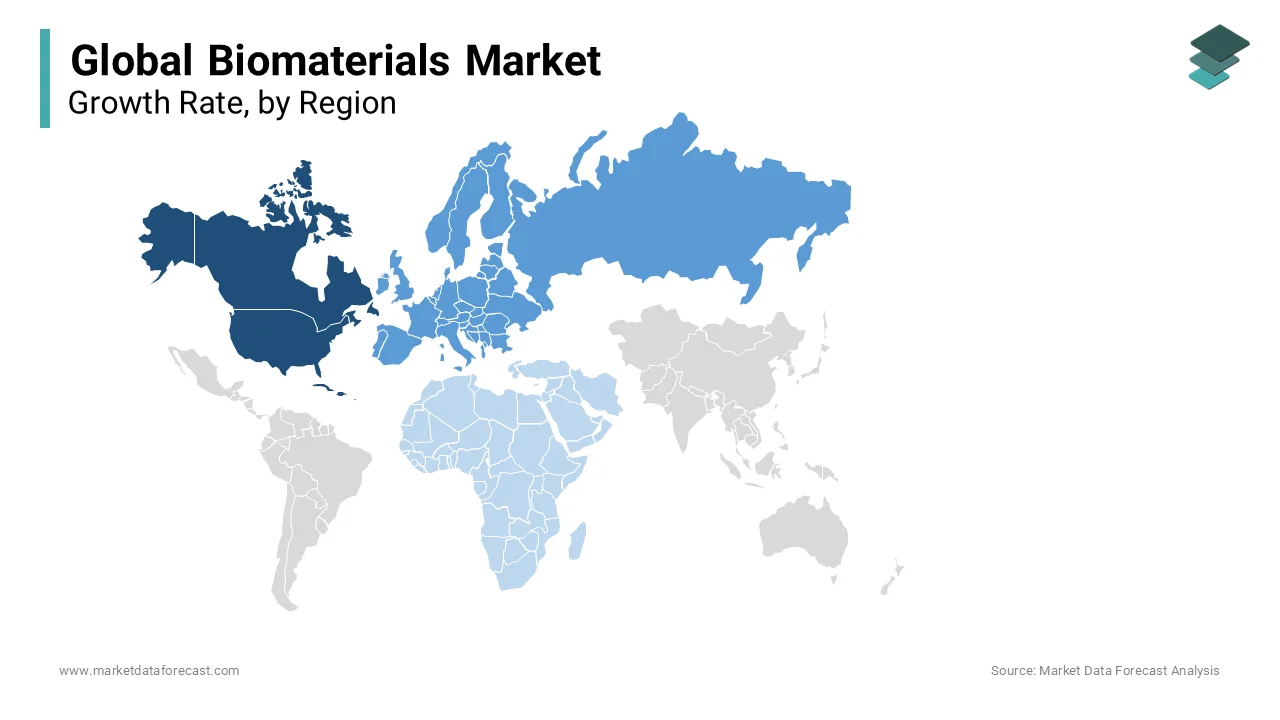Global Biomaterials Market Size, Share, Trends & Growth Forecast Report - Segmented By Material Type (Ceramic Biomaterials, Metallic Biomaterials, Polymer Biomaterials and Natural Biomaterials, Application and Region (North America, Europe, Asia-Pacific, Latin America, Middle East and Africa) - Industry Analysis (2025 to 2033)
Global Biomaterials Market Size
The global biomaterials market size was valued at USD 144.42 billion in 2024. The biomaterials market size is expected to have 14.5% CAGR from 2025 to 2033 and be worth USD 488.51 billion by 2033 from USD 165.36 billion in 2025.

A biomaterial is any substance or combination of synthetic or natural origin. Biomaterials are vital in orthopedic surgeries, most notably in knee replacements. According to the Journal of Bone and Joint Surgery, knee replacement demand will rise enormously in the coming years. A similar source proposes the need for entire hip replacements to register 572,000 patients by 2030. With such an incredible increase in demand in the orthopedic sector, the biomaterials market will soon be subject to significant growth. Nanotechnology contributions researchers are working on recovering energy from the human body to use power to operate implantable biomedical devices.
The biomaterials market, presently, is growing at a healthy pace. The market is experiencing the development and introduction of novel materials for the creation of several kinds of constructs which can link directly to tissues has provided the progress of such domains of science as regenerative engineering, tissue, and medicine. Existing strategies for tissue engineering and regenerative strategies strive to restore the operations of damaged tissues. The present gold criteria are autografts (utilising the patient’s tissue to boost healing), but restrictions like insufficient procurement of some tissues, prolonged operative period, and donor place morbidity have authorised the search for substitute options.
MARKET DRIVERS
The growing aging population and rising prevalence of chronic diseases worldwide drive the global biomaterials market growth.
The usage of biomaterials in various procedures has increased significantly in recent years including orthopedic implants, cardiovascular stents, dental implants and tissue engineering. The number of people aging worldwide is on the rise. As per the statistics published by the World Health Organization (WHO), the number of people with age 60 years or above is expected to reach 2.1 Billion worldwide. People are more likely to suffer from various diseases and require medical interventions such as joint replacements, cardiovascular procedures, and dental implants. Biomaterials are the finest materials used in the manufacturing of implants and devices and are compatible with the human body. Medical devices and medical implants that are manufactured with biomaterials promote successful integration and offer a reduced risk of complications. On the other hand, the number of people suffering from chronic diseases is growing rapidly worldwide. The growing prevalence of chronic diseases is driving the demand for the materials and components that are required for the manufacturing of medical devices, including biomaterials. This trend is likely to continue in the coming years and drive the market growth.
The growing demand for regenerative medicine further fuels the growth rate of the biomaterials market.
Biomaterials are being used in the development of regenerative medicine. The adoption of regenerative medicine has increased tremendously in recent years due to its ability to repair or replace damaged tissues and organs. The usage of regenerative medicine is expected to grow in the coming years due to the increasing prevalence of chronic diseases and rising demand for effective treatments driving the demand for biomaterials and boosting market growth.
The rising number of advancements in biomaterials science and technology, increasing awareness of biocompatibility, growing funding, and an increasing number of initiatives from the governments of various countries to support the R&D in the field of biomaterials, rising emphasis on personalized medicine and growing emphasis on developing sustainable and eco-friendly materials across industries boost the market’s growth rate. The compatibility of biomaterials with 3D printing and the growing number of R&D activities by academic institutions, research organizations, and companies to explore the potential benefits of biomaterials in various applications further propel the biomaterials market growth.
The increasing incidence of chronic diseases and the rising ageing population worldwide are driving the growth of the biomaterials market. Moreover, because of the surge in the advancement of new biomaterials, the need for medical grafts, and the escalating prevalence of cardiovascular conditions, show the growing subsidies and grants under the medical policies of several nations around the world. Besides this, high application for this form of material in plastic surgery is likely, which will also lead to broader use of this type of material. Also, rising investments in Research and development projects are propelling the market growth.
MARKET RESTRAINTS
Factors like the high cost of biomaterial production and polymers, inflammatory responses found because of compatibility issues, and complications with these products limit the growth rate of the global biomaterials market. Lack of knowledge of biomaterial devices is slowly hampering demand for the market. The equipment in the laboratories requires massive amounts for maintenance and installation; strict rules and regulations taken by the government in concern for patients' health are limiting the market's growth.
The expansion of the biomaterials market is impeded by the heightened cost of biomaterial manufacturing and polymers, the complexities linked with these, and the inflammation responses. Moreover, the requirement for large capital expenditures for setting up laboratories are also affecting the market progress.
REPORT COVERAGE
|
REPORT METRIC |
DETAILS |
|
Market Size Available |
2024 to 2033 |
|
Base Year |
2024 |
|
Forecast Period |
2025 to 2033 |
|
Segments Covered |
Based on Type, Application, and Region |
|
Various Analyses Covered |
Global, Regional & Country Level Analysis, Segment-Level Analysis, DROC, PESTLE Analysis, Porter’s Five Forces Analysis, Competitive Landscape, Analyst Overview of Investment Opportunities |
|
Key market players |
Carpenter Technology Corporation, Evonik Industries, Berkeley Advanced Biomaterials, Royal DSM, BASF SE, Corbion, Cam Bioceramics B.V., Celanese Corporation, CoorsTek Inc., CeramTec, and GELITA AG. |
|
Regions Covered |
North America, Europe, Asia Pacific, Latin America, Middle East & Africa |
SEGMENTAL ANALYSIS
By Biomaterial Type Insights
The metallic biomaterials segment accounted for the largest share of the global biomaterials market in 2024 and the segmental domination is expected to continue throughout the forecast period. The rising use of metals in manufacturing cardiovascular, dental and orthopedic medical devices is one of the key factors propelling the segmental growth. Since biomaterials are made up of artificial or natural materials, metals are also used to manufacture implants, fabricate structures, or replace lost or diseased biological structures and this help in improving the quality of life and longevity of human beings since metals have excellent properties of thermal conductivity and other mechanical properties, which makes them find application in many fields, such as in stents in blood vessels, artificial valves in the heart, replacement implants in elbows, hips, ears, shoulders, knees, and orthodontal structures. Thus, to meet the demands of the rapidly aging population, this segment is expected to grow at a high rate over the forecast period.

However, the segment of polymeric biomaterials is expected to grow at the fastest CAGR during the forecast period due to the increasing use of polymers in soft tissue applications such as plastic surgery. The growing use of polymers in healthcare and soft tissue, such as plastic surgeries, drives segmental growth. For many years, researchers have developed many new strategies for the exploration of Natural and synthetic polymers to successfully design advanced polymer biomaterials to be applied in the field of tissue engineering and regeneration, a fast-growing industry at a high pace in recent years. Therefore, recent technological advancements have advanced self-healing and shape-memory properties in preparing innovative polymeric biomaterials. This has helped the manufacturers approach new methods of developing hydrogels, films, and 3D printable biomaterials using different polymeric biomaterials. In addition, its properties like flexibility, longevity, biocompatibility, bioinertness, and durability have increased ophthalmological disorders. Based on usage, both biodegradable and bio-stable polymers are used in healthcare. Thus, these factors are hoping to drive the market over the forecast period under this segment.
Metallic biomaterials are extensively utilised for clinical applications. This segment is believed to possess the largest market share of biomaterials because of a greater blend of mechanical qualities and longevity than the polymeric and ceramic options. Moreover, these biomaterials are majorly applied in surgery and prosthetics which significantly contributed to the expansion of the segment's market size in recent years. Besides these, currently, multiple scientific studies are being conducted on new materials called Biodegradable metal scaffolds exhibiting the same or comparable qualities to human bone.
By Application Insights
The orthopedic segment accounted for the major share of the global biomaterials market in 2024 and is expected to grow at a healthy CAGR during the forecast period.
The dental segment is predicted to grow at a promising CAGR during the forecast period owing to the rising concern for healthcare and the growing urban population. The rising awareness of next-generation sequencing techniques and increasing usage of biomaterials in various applications further contribute to segmental growth.
The neurological segment is also anticipated to hold a considerable share of the global market during the forecast period. The growing number of people suffering from neurological disorders primarily boosts segmental growth. Thus, there has been a growing need for effective treatment methods for these diseases, resulting in market players and manufacturers shifting focus on biomaterials with the efforts underway to produce an ideal scaffold. They aim to improve the limitations of purely cellular therapies, produce biomaterials that exactly match the biological and mechanical properties of the tissue, and also study the philosophy of neural tissue engineering, which has emerged recently.
Orthopedic is the most common application in the biomaterials market. These are used in orthopedic implants, bone grafts, and joint replacement. These materials have changed the approach to tissue engineering, drug delivery, diagnostics, and more. According to a 2024 study, around 766 thousand hip replacement procedures happened between 2024 and 2033, a growth of 3.8 per cent.
REGIONAL ANALYSIS
Geographically, North America is leading the biomaterials market and is expected to maintain its position during the forecast period. The region’s market growth can be attributed to the rising prevalence of cardiac and cardiovascular diseases. Every year in the United States over 900 thousand cardiac surgeries are performed. Apart from this, the escalating application is associated with technological developments, particularly those including nanotechnology for providing molecular treatments.

Europe is a prominent biomaterials market and is believed to drive at a steady rate throughout the estimation period. Favourable government regulations, a well-known industrial ecosystem and facilities, and increasing investments and innovations by prominent players are propelling the segment’s market growth. Various Germany-based companies support and emphasize facilitating secure and more biocompatible materials in the future. The APAC biomaterials market is predicted to witness the fastest CAGR in the global market during the forecast period. The rapidly improving healthcare infrastructure, increasing healthcare expenditure, growing prevalence of chronic diseases, increasing middle-class population, rising medical tourism industry, growing adoption of patients seeking advanced biomaterial-based treatments and increasing focus on research and development, particularly in countries like Japan and South Korea, promote the APAC market growth. The growth of 3D printing technology for customized biomaterial implants and increasing government initiatives to promote domestic production and innovation in biomaterials further contribute to the APAC market growth.
Latin America's biomaterials market is estimated to hold a considerable share of the global market during the forecast period. The growing healthcare spending, improving healthcare infrastructure, rising medical device industry and rising demand for biomaterial-based implants, growing prevalence of chronic diseases, such as cardiovascular disorders and diabetes and expansion of private healthcare sector and medical tourism propel the Latin American market growth. The growing awareness and adoption of regenerative medicine and tissue engineering and the increasing number of initiatives from the governments of Latin American countries to enhance research capabilities and attract investments in biomaterials boost the Latin American market growth.
MEA biomaterials market held a moderate share of the global market in 2024 and is predicted to grow steadily during the forecast period owing to the rising demand for biomaterial-based orthopedic and dental implants and the increasing number of initiatives from the governments of MEA countries to develop domestic manufacturing capabilities in biomaterials.
KEY MARKET PLAYERS
Some of the noteworthy players in the global biomaterials market covered in this report are Carpenter Technology Corporation (United States), Evonik Industries (Germany), Berkeley Advanced Biomaterials (United States), Royal DSM (Netherlands), BASF SE (Germany), Corbion (Netherlands), Cam Bioceramics B.V. (Netherlands), Celanese Corporation (United States), CoorsTek Inc. (United States), CeramTec (Germany), and GELITA AG (Germany).
RECENT HAPPENINGS IN THIS MARKET
- In September 2024, an international conference at the 2024 Bio Asia-Taiwan was held at the National Taipei University of Technology (NTUT) by the High-Value Biomaterials Research and Commercialization Center (HBRCC). The forum concentrated on models for international partnership in the field of biomaterials and the exchange of experiences between academia-industry collaboration by the attending experts.
- In May 2024, BIO INX, a Bioink technology company, with Readily3D, a volumetric 3D printing firm to launch new biomaterials for volumetric 3D bioprinting.
- In April 2024, Omid Veiseh, a Rice University bioengineer, and collaborators discovered new formulations for biomaterials that can assist in making a fresh start in treating type 1 diabetes. This will pave the way for a more endurable, tenable, lasting, self-governing method of managing the disease. Further, providing a host immune system to stand and support the existence of implanted insulin-secrete cells in more than 700 million type 1 diabetes people worldwide can be transformative.
MARKET SEGMENTATION
This research report has segmented and sub-segmented the global biomaterials market into categories based on biomaterial type, application, and region.
By Biomaterial Type
- Ceramic Biomaterials
- Metallic Biomaterials
- Polymer Biomaterials
- Natural Biomaterials
By Application
- Orthopedic
- Dental
- Cardiovascular
- Plastic surgery
- Wound healing
- Ophthalmology
- Tissue engineering
- Neurological
- Others
By Region
- North America
- Europe
- Asia Pacific
- Latin America
- The Middle East and Africa
Frequently Asked Questions
Which region is growing the fastest in the global Biomaterials market?
Geographically, the North American Biomaterials market accounted for the largest share of the global market in 2024.
Which are the significant players operating in the Biomaterials market?
Evonik Industries (Germany), Berkeley Advanced Biomaterials (United States), Royal DSM (Netherlands), BASF SE (Germany), Corbion (Netherlands), Cam Bioceramics B.V. (Netherlands), Celanese Corporation (United States), CoorsTek Inc. (United States) are some of the significant players operating in the Biomaterials market
How much is the global Biomaterials market going to be worth by 2033?
As per our research report, the global Biomaterials market size is projected to be USD 488.51 billion by 2033.
At What CAGR, the global Biomaterials market is expected to grow from 2025 to 2033 ?
The global Biomaterials market is estimated to grow at a CAGR of 14.5% from 2025 to 2033.
Related Reports
Access the study in MULTIPLE FORMATS
Purchase options starting from $ 2500
Didn’t find what you’re looking for?
TALK TO OUR ANALYST TEAM
Need something within your budget?
NO WORRIES! WE GOT YOU COVERED!
Call us on: +1 888 702 9696 (U.S Toll Free)
Write to us: [email protected]
